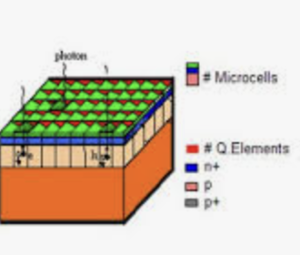
Silicon Photomultipliers (SiPMs), also known as Multi-Pixel Photon Counters (MPPCs), are advanced solid-state photodetectors renowned for their ability to detect low-light levels with high sensitivity. Widely used in medical imaging, particle physics, and LiDAR, SiPMs combine the benefits of traditional photomultiplier tubes (PMTs) and avalanche photodiodes (APDs) while overcoming many of their limitations. This article delves into their structure, operation, applications, and recent advancements.
Structure of SiPMs
An SiPM consists of a densely packed array of microcells (typically 100–10,000/mm²), each acting as a single-photon avalanche diode (SPAD) operating in Geiger mode. Key structural components include:
Microcells: Tiny APDs biased above their breakdown voltage (~30–70 V).
Quenching Resistor: Integrated into each microcell to halt the avalanche by reducing the bias voltage, allowing recovery.
Common Output: Signals from all microcells are summed, providing a scalable output proportional to detected photons.
Working Principle
Photon Absorption: A photon entering a microcell generates an electron-hole pair.
Avalanche Multiplication: The high electric field triggers impact ionization, creating a self-sustaining avalanche.
Quenching: The quenching resistor limits current, dropping the bias below breakdown, stopping the avalanche.
Recharge: The microcell recharges via the resistor, with recovery time determining dead time (~10–100 ns).
Signal Output: The summed output of all fired microcells provides a measurable current, enabling photon counting.
Key Characteristics
Photon Detection Efficiency (PDE):
Depends on quantum efficiency, avalanche triggering probability, and fill factor (active area ratio).
Peak sensitivity in visible to near-infrared (400–900 nm).
Gain:
High gain (~10⁵–10⁶), comparable to PMTs, due to Geiger-mode operation.
Noise Sources:
Dark Count Rate (DCR): Thermal electron-induced false counts (kHz–MHz/mm²), temperature-dependent.
Optical Crosstalk: Photons from one avalanche triggering neighboring microcells (1–30% probability).
Afterpulsing: Trapped charges releasing post-avalanche, causing delayed pulses.
Dynamic Range: Limited by microcell count; saturation occurs when all cells fire.
Temperature Sensitivity: Breakdown voltage shifts with temperature, necessitating bias voltage compensation.
Advantages vs. Traditional Detectors
Solid-State Design: Compact, robust, and resistant to magnetic fields.
Low Voltage Operation: 30–70 V vs. kV for PMTs.
High PDE: Superior to PMTs in near-infrared.
Photon Number Resolution: Capable of resolving photon counts up to microcell density limits.
Disadvantages
Higher DCR and crosstalk compared to PMTs.
Limited dynamic range due to microcell saturation.
Temperature sensitivity requiring thermal management.
Applications
Medical Imaging:
PET Scans: SiPMs enable time-of-flight measurements, improving image resolution.
Fluorescence Detection: Used in microscopy and flow cytometry.
LiDAR:
Employed in autonomous vehicles for precise, fast distance measurement.
High-Energy Physics:
Particle detection in magnetic environments (e.g., CERN experiments).
Astrophysics:
Cherenkov telescope arrays for gamma-ray detection.
Quantum Technologies:
Single-photon detection in quantum communication and computing.
Comparison with Other Photodetectors
| Feature | SiPM | PMT | APD |
|---|---|---|---|
| Gain | 10⁵–10⁶ | 10⁶–10⁷ | 10²–10³ |
| Voltage | 30–70 V | 1–3 kV | 50–300 V |
| Magnetic Field | Insensitive | Sensitive | Insensitive |
| Size | Compact | Bulky | Small |
| Cost | Moderate | High | Low |
Recent Developments
Digital SiPMs: Integration of readout electronics for enhanced signal processing.
Reduced Crosstalk: Advanced trench isolation and optical barriers.
Enhanced PDE: Improved microcell design and anti-reflective coatings.
Temperature Compensation: On-chip circuits for stable operation.
Leading Manufacturers: Hamamatsu, ON Semiconductor (SensL), Broadcom, Excelitas.
Conclusion
SiPMs represent a transformative leap in photodetection, offering unparalleled sensitivity, compactness, and versatility. While challenges like noise management persist, ongoing advancements continue to expand their applications in science and industry. As technology evolves, SiPMs are poised to become integral to next-generation imaging, sensing, and quantum systems.
- Everything You Need To Know About Limit Switch - May 21, 2025
- Everthing You Should Know About Rheostat - May 20, 2025
- Everything You Need To Know About Reversing Contactor - May 19, 2025






